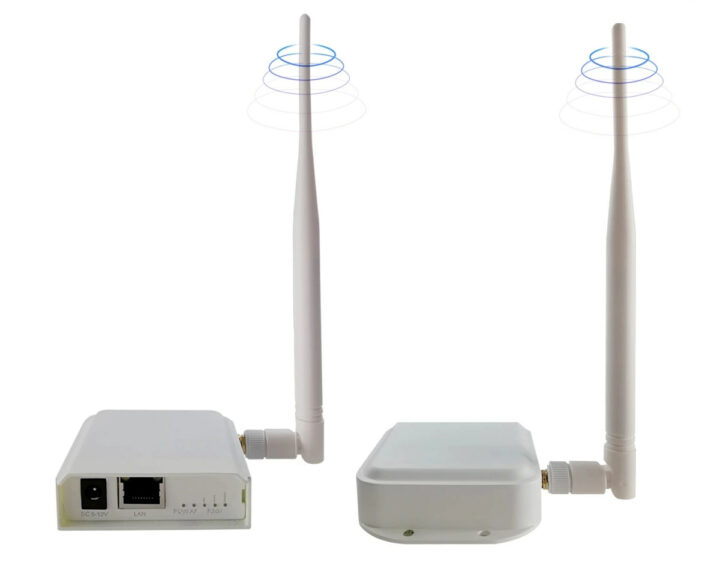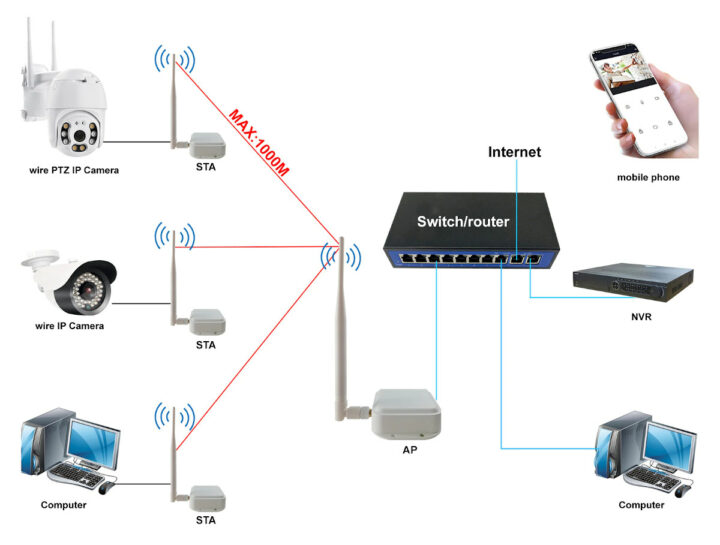I’m starting to better understand what Wi-Fi HaLow (aka 802.11ah) is for, after seeing a kit with two WiFI HaLow gateways used to wirelessly extend the range of Ethernet connected nodes on the LAN, including IP cameras, to several hundred meters, far more than your typical WiFi repeater, but at the cost of a lower bitrate.
Yesterday, I wrote about Halo TD-XPAH, the first easily procurable 802.11ah WiFi HaLow development board I had seen, since the introduction of the new standard in 2014. But I was told another lower-cost HaLow board had been available for a few months on Alibaba, and while I failed to find it on Aliexpress, I discovered a pack with two WiFi HaLow to Ethernet gateway that could easily help extend the range of WiFi nodes like security cameras and selling for about $65 shipped.
 STK-AH9066 WiFi HaLow gateway specifications:
STK-AH9066 WiFi HaLow gateway specifications:
- Wireless
- 802.11ah Wi-Fi HaLow standard
- 902-930MHz or 760-790MHz frequency band.
- Range
- Up to 1km for 1080p video with Line-of-Sight (more details below)
- Up to 150 meters through 3-4 concrete walls
- Bandwidth allocation – 1MHz, 2MHz, 4MHz, or 8MHz
- 2dBi Antenna
- Wired- 10/100M Ethernet port
- Misc – 5 LEDs for power, connection status, RSSI (signal strength)
- Power Supply – 5V/1A via DC jack
- Dimensions – 70 x 51 x 22 mm without antenna; antenna: 19 cm long
- Temperature Range – -20°C to +48°C
- FCC ID – 2AXPI-TX-AH-R900ATR
 Unlike most WiFi routers running Linux distributions like OpenWrt, the HaLow gateway is likely based on a Newracom chip meaning Arm Cortex-M0/M3 microcontroller with firmware written in C language. The manufacturer, which should be Zhuhai Huge-ic Co.,Ltd according to FCC filings, also calls this type of system “Air Ethernet” since it adds wireless connectivity to Ethernet hosts like IP cameras, computers, or laptops. Note there’s no support for 2.4 GHz 802.11b/g/n WiFi at all, so this gateway only works with Ethernet. I understand each gateway can be configured as either an access point or a client (STA), and one access point can handle up to four clients.
Unlike most WiFi routers running Linux distributions like OpenWrt, the HaLow gateway is likely based on a Newracom chip meaning Arm Cortex-M0/M3 microcontroller with firmware written in C language. The manufacturer, which should be Zhuhai Huge-ic Co.,Ltd according to FCC filings, also calls this type of system “Air Ethernet” since it adds wireless connectivity to Ethernet hosts like IP cameras, computers, or laptops. Note there’s no support for 2.4 GHz 802.11b/g/n WiFi at all, so this gateway only works with Ethernet. I understand each gateway can be configured as either an access point or a client (STA), and one access point can handle up to four clients.
The 900 MHz frequency band used by the 802.11ah enables both longer range and penetration through obstacles like walls. I’d assume there must be a web configuration interface to select the 760-790MHz (e.g. China) or 902-930MHz (e.g. US, South East Asia) band to comply with local regulation. While it’s possible to get a connection of over 1km, the bandwidth may not be sufficient to transmit video. Another way to look at the range is a video from Newracom with another device equipped with their NRC7292 chip showing low-bitrate video transmission of up to 500-600 meters, and still getting a ping up to nearly 1.5 km away, all without large obstacles such as buildings.

Jean-Luc started CNX Software in 2010 as a part-time endeavor, before quitting his job as a software engineering manager, and starting to write daily news, and reviews full time later in 2011.
Support CNX Software! Donate via cryptocurrencies, become a Patron on Patreon, or purchase goods on Amazon or Aliexpress




